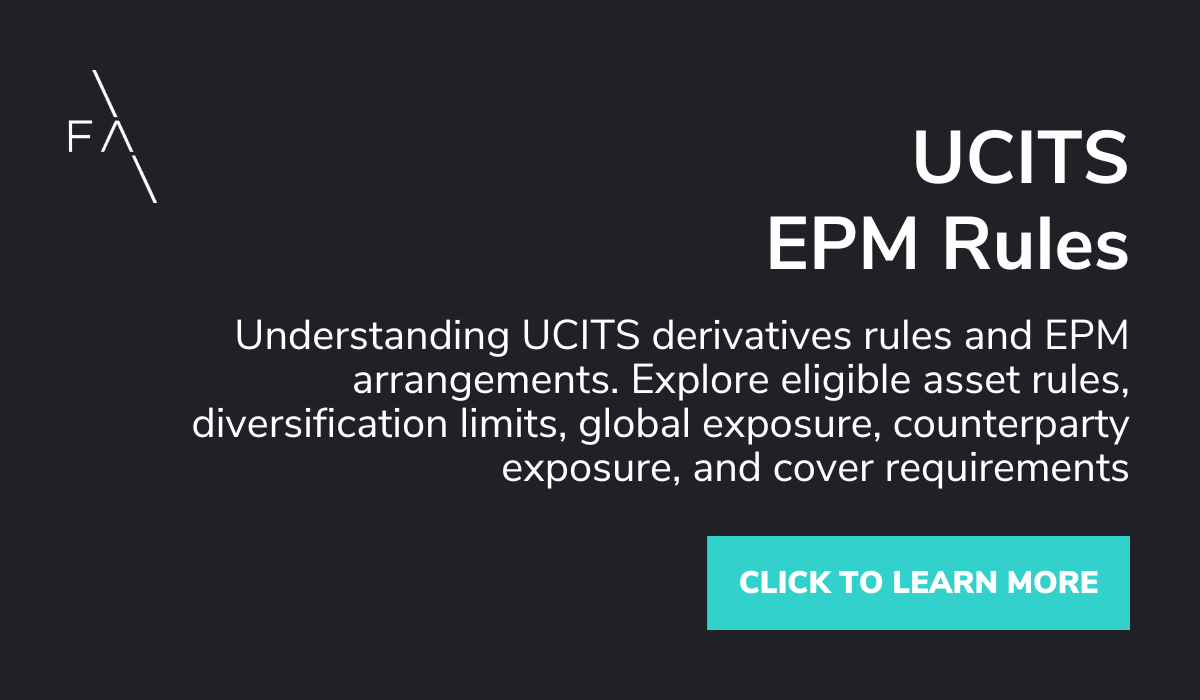Below, we’ve listed the key provisions of UCITS Investment Rules. These rules involve a considerable level of complexity, especially regarding asset eligibility, treatment of derivatives, derivative exposure calculation, netting/hedging arrangements, and the impact of EPM techniques like stock lending, repos, and reinvestment of collateral.

ELIGIBLE ASSET RULES
Article 50(1) sets out eligible assets in which a UCITS scheme may invest. These assets, include:
Transferable securities and money market instruments;
Units of UCITS and/or other (open ended) collective investment undertakings;
Deposits;
Financial derivative instruments dealt in on a regulated market or over the counter; and
Warrants.
The eligibility of each of the above assets type is subject to certain conditions being met. These conditions are set out in the UCITS Directive and in the EAD and ESMA’s Guidelines.
For further details, see the Funds-Axis Guide to UCITS Eligible Assets.
Based on this, we have a range of identifiable rules, including, the following:
No acting as guarantor
No granting loans
No precious metals
No certificates representing precious metals
No real estate
No commodities
No Physical Short Selling
Securities must be eligible transferable securities
Closed end funds must be regulated
Closed end funds must have segregation of assets
Closed end funds must have appropriate governance mechanisms
MMI must be approved MMI
CIS invested into which are not UCITS must be equivalent to UCITS
CIS invested into must invest max. 10% of their NAV in other CIS
Deposits must have a maturity of less than 12 months or be repayable upon demand
Deposits must be made with acceptable credit institutions
Derivatives must have eligible underlyings
OTC derivatives must be with acceptable counterparties
OTC derivatives must be capable of reliable valuation
DIVERSIFICATION RULES
Below we identify the key diversification rules. In applying these rules, there is a requirement to aggregate the direct exposures with any indirect exposures through derivatives, although with an exemption for eligible index tracking derivatives.
Deposits, Cash and borrowing
Max 20% NAV with any one deposit taker
UCITS must be fully invested (typically, max 10% aggregate in un-invested cash)
Max 10% NAV borrowing
Borrowing must be temporary
Transferable securities and Money Market Instruments (includes closed end funds and structured products)
Max 10% NAV not in transferable securities and money market instruments, not on approved markets
Max 5% NAV with anyone one Issuer, but with max 10% NAV with any one issuer for up to 40% of NAV
For Government bonds, Max 35% NAV in any one issuer, unless greater exposure is permitted by prospectus, in which case:
– Max 100% in any one issuer
– Max 30% in any one issue
– Minimum 6 different issuesFor covered bonds, max 5% NAV with anyone one Issuer, but with max 25% NAV with any one issuer for up to 80% of NAV.
Investment into Collective Investment Schemes
Max 20% NAV in any one other CIS
Max 30% NAV in aggregate investment in non- UCITS schemes
SIGNIFICANT INFLUENCE AND CONCENTRATION RULES
There are also significant influence and concentration rules as regards how much you can own of the issued capital / voting shares in issue of the securities invested into. In summary, these are:
Max 20% of the voting shares issued by an issuer
Max 10% of the non-voting shares issued by an issuer
Max 10% of the debt shares issued by an issuer
Max 10% of the MMI issued by an issuer
Max 25% of the units issued by any collective investment scheme.
GLOBAL EXPOSURE – LEVERAGE OR MARKET RISK
UCITS can have a maximum of 100% NAV global exposure, calculated either as:
Leverage – 100% incremental derivative exposure, calculated using the commitment approach, with provisions including for netting and hedging; or
VAR, being:
– Relative VaR – A maximum of 2 times the VaR of a benchmark portfolio; or
– Absolute VaR – A maximum of 20% Absolute VaR.
VaR must be used where the leverage approach is not sufficient.
VaR is measured using a 99% confidence level over a holding period of at least 20 business days and at least one years of historic data. There are also requirements in respect of stress testing, back-testing and reporting of “overshoots.”
COUNTERPARTY EXPOSURE
UCITS can have a maximum of 5% NAV exposure to any one counterparty through OTC derivatives. This includes any broker margin posted to counterparties. This is increased to 10% NAV for approved credit institutions.
AGGREGATED EXPOSURE RULES
UCITS are subject to aggregated exposure rules. These require the UCITS to consider all their exposures to the single group, including through:
Transferable securities and money market instruments (including look-through of derivatives);
Deposits;
OTC counterparty exposure; and
Stock lending counterparty exposure.
The aggregated exposure rules are:
Max 20% aggregated exposure to any one single group, excluding exposure to Government and Public securities issuers and exposure to covered bonds; and
Max 35% consolidated exposure to any single group, excluding exposure to Government and Public securities issuers.
COVER
To ensure the financial stability of UCITS and their ability to fulfill their obligations, specific cover requirements are in place. These requirements vary based on the nature of the obligations. Notably, when dealing with short derivatives, considerations include whether the derivative is physically or cash settled, and if the underlying asset to be delivered is highly liquid.
It’s important to highlight that these cover provisions not only safeguard UCITS’ obligations but also play a pivotal role in preventing physical short selling. In essence, the rules pertaining to short derivatives can be summarized as follows:
- Specific Cover for physically settled short derivatives on less liquid underlyings
- Liquid Assets Cover required for other Derivative Obligations
By adhering to these rules, UCITS can confidently navigate their investment strategies while upholding their responsibilities and safeguarding investor interests.








